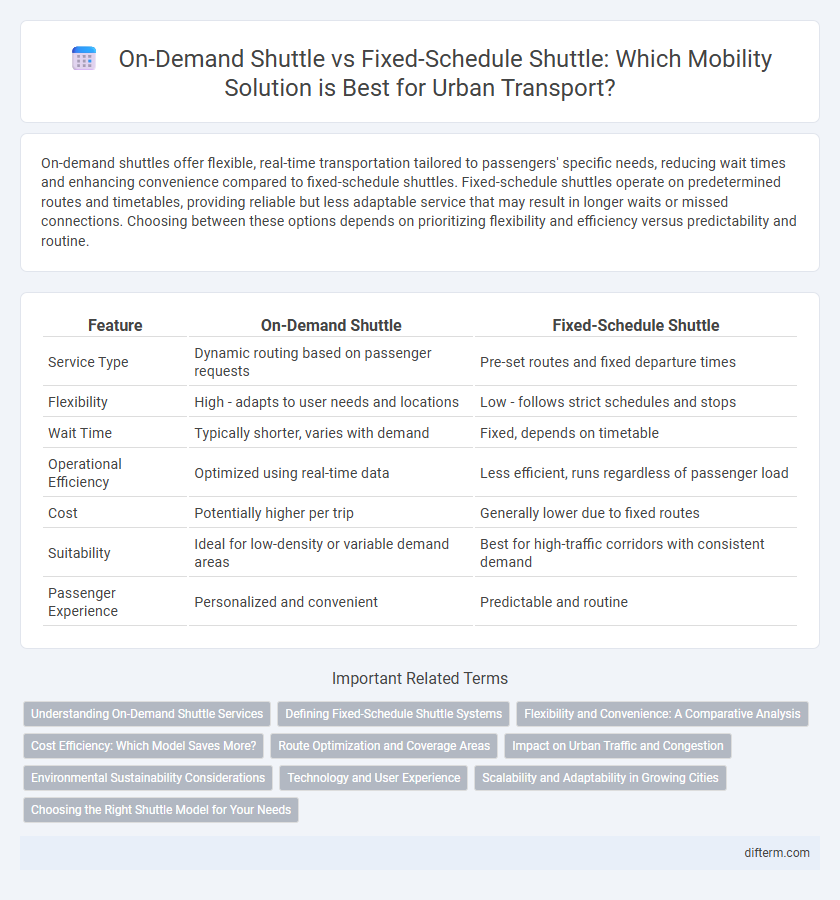On-demand shuttles offer flexible, real-time transportation tailored to passengers' specific needs, reducing wait times and enhancing convenience compared to fixed-schedule shuttles. Fixed-schedule shuttles operate on predetermined routes and timetables, providing reliable but less adaptable service that may result in longer waits or missed connections. Choosing between these options depends on prioritizing flexibility and efficiency versus predictability and routine.
Table of Comparison
| Feature | On-Demand Shuttle | Fixed-Schedule Shuttle |
|---|---|---|
| Service Type | Dynamic routing based on passenger requests | Pre-set routes and fixed departure times |
| Flexibility | High - adapts to user needs and locations | Low - follows strict schedules and stops |
| Wait Time | Typically shorter, varies with demand | Fixed, depends on timetable |
| Operational Efficiency | Optimized using real-time data | Less efficient, runs regardless of passenger load |
| Cost | Potentially higher per trip | Generally lower due to fixed routes |
| Suitability | Ideal for low-density or variable demand areas | Best for high-traffic corridors with consistent demand |
| Passenger Experience | Personalized and convenient | Predictable and routine |
Understanding On-Demand Shuttle Services
On-demand shuttle services dynamically adjust routes and pick-up times based on real-time passenger requests, offering greater flexibility compared to fixed-schedule shuttles that run on predetermined timetables. These services leverage GPS data and mobile app integration to optimize efficiency, reduce wait times, and enhance user convenience. By matching supply with fluctuating demand, on-demand shuttles contribute to decreased operational costs and improved urban mobility.
Defining Fixed-Schedule Shuttle Systems
Fixed-schedule shuttle systems operate on predetermined routes and timetables, ensuring consistent and predictable service for passengers. These systems optimize fleet management by adhering to set departure and arrival times, enhancing operational efficiency. Compared to on-demand shuttles, fixed-schedule models prioritize route reliability and regularity over flexible routing.
Flexibility and Convenience: A Comparative Analysis
On-demand shuttles offer superior flexibility by allowing passengers to request pickups and drop-offs tailored to their specific locations and schedules, reducing wait times and optimizing routes dynamically. Fixed-schedule shuttles operate on predetermined routes and timetables, providing predictable service but limited adaptability to individual needs. This comparative analysis highlights on-demand shuttles as a more convenient solution for personalized mobility, while fixed-schedule shuttles ensure reliability in high-demand corridors.
Cost Efficiency: Which Model Saves More?
On-demand shuttles optimize route planning using real-time passenger data, reducing fuel consumption and operational costs compared to fixed-schedule shuttles that run regardless of demand levels. Fixed-schedule services often incur higher expenses due to empty seats during off-peak hours and rigid timing. Studies indicate that on-demand models can lower per-passenger costs by up to 30%, making them more cost-efficient for urban mobility solutions.
Route Optimization and Coverage Areas
On-demand shuttles utilize real-time route optimization algorithms to dynamically adjust routes based on passenger requests, significantly improving coverage areas by reaching underserved locations. Fixed-schedule shuttles operate on predetermined routes and timetables, limiting flexibility and often resulting in inefficient coverage, especially during off-peak hours. Integrating on-demand services enhances overall mobility by maximizing vehicle utilization and expanding accessible transit zones.
Impact on Urban Traffic and Congestion
On-demand shuttles reduce urban traffic congestion by optimizing routes and minimizing empty trips, resulting in fewer vehicles on the road at peak times. Fixed-schedule shuttles often run predefined routes regardless of demand, leading to underutilized capacity and increased traffic buildup. Integrating on-demand shuttle services with existing public transit networks can lead to more efficient traffic flow and lower congestion levels in dense urban areas.
Environmental Sustainability Considerations
On-demand shuttles optimize route efficiency by reducing empty miles, leading to lower greenhouse gas emissions compared to fixed-schedule shuttles that often run underutilized. Energy consumption decreases significantly when vehicle deployment aligns with real-time passenger demand, minimizing unnecessary fuel use. Implementing electric or hybrid on-demand shuttles further enhances environmental sustainability by cutting reliance on fossil fuels and reducing overall carbon footprints.
Technology and User Experience
On-demand shuttles leverage advanced GPS tracking and real-time data analytics to dynamically adjust routes, enhancing passenger convenience by reducing wait times and wait locations. Fixed-schedule shuttles operate on predetermined routes and timetables, which simplify planning but may lead to inefficiencies and limited flexibility for users. The integration of mobile apps with on-demand services allows seamless booking and live updates, significantly improving the overall user experience compared to traditional fixed-schedule systems.
Scalability and Adaptability in Growing Cities
On-demand shuttles offer superior scalability compared to fixed-schedule shuttles by dynamically adjusting routes and frequencies based on real-time passenger demand, reducing operational inefficiencies in growing cities. Their adaptability allows rapid response to urban expansion and changing mobility patterns, supporting fluctuating populations without the need for costly infrastructure changes. Fixed-schedule shuttles struggle to match this flexibility, often resulting in underutilized capacity or overcrowding as city dynamics evolve.
Choosing the Right Shuttle Model for Your Needs
Choosing the right shuttle model depends on factors such as passenger demand, route flexibility, and operating costs. On-demand shuttles offer customized routes and real-time scheduling ideal for variable ridership and reducing wait times. In contrast, fixed-schedule shuttles provide predictable service on established routes, optimizing efficiency for high-density areas with regular commuter patterns.
on-demand shuttle vs fixed-schedule shuttle Infographic

 difterm.com
difterm.com